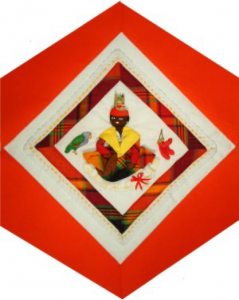Dominica

The Block
A three-dimensional representation of a Dominican woman dressed in traditional clothing is the central figure of this block, made by Sheila Hill. Her costume consists of a long-sleeved madras dress over a white chemise, a petticoat trimmed with lace peaking from beneath the dress, and a bright cotton foulard (scarf) draped over her shoulders. A headdress (tied in a distinctive manner indicating romantic commitment) and gold jewelry finish her ensemble. On either side of the woman is an embroidered national symbol – to the right a Sisserou parrot, one of two parrots found nowhere else in the world, and to the left, bwa carib (carib wood), the national flower. The eyelet lace outlining the inner madras frame is threaded with ribbon. Dominican women will often do this to achieve a more colourful effect, reflecting their exuberant nature.
Cultural Profile
Dominica, located between the Caribbean Sea and the North Atlantic Ocean, is an island of remarkable mountain ranges, towering waterfalls and numerous, pristine rivers. According to popular legend, there are as many rivers as there are days of the year. It was named by Christopher Columbus for the day of the week on which he spotted it (Sunday), but is also known as the ‘Nature Island of the Caribbean.’ Dominica is home to the world’s biggest volcanically-heated lake, Boiling Lake.
English is the official language, although a French patois is also widely spoken. The people are warm and friendly, creative and resourceful. Dominica is home to a large numbers of centenarians. Their numbers are three times higher than in industrialized countries, a fact that is currently being investigated in order to understand why people live longer on this island.
The island is home to the Carib Territory, since 1903, the largest indigenous territory in the Caribbean islands. Though the Carib language is not in use anymore, the culture, traditions and crafts of the original Carib have been preserved, thanks in part to the territory’s isolation from the rest of the island for most of the 20th century. Today, local Kalinago artisans still make calabash products, pottery, dug-out canoes from the gommier trees, as well as baskets from the larouma plant.
British, French and West Indian influences have contributed to a culture as diverse as Dominica’s topography, which includes strong traditions in theatre, music and dance. The Jing ping music style is a traditional Dominican music style that features accordion, tanbal drums, boom-booms ( long, hollow pieces of wood or bamboo), and metal percussion cylinders. Bele, a traditional dance performed by two dancers, portrays a stylized courtship. It demonstrates how African traditional dances have travelled across the Atlantic to be reinterpreted by the descendants of slaves brought over during the French and British regimes.
Annual events such as the World Creole Music Festival, Carnival, called the Mas Dominik, and Domfesta, celebrate the country’s rich heritage, which is reflected in the colourfully costumed participants. These festivities allow generations of dancers, storytellers, lapo kabwit (goatskin) drummers, singers, and painters to express their versatility. National crafts also include basketry woven from palm fronds, grass mats and embroidery.
Emigration from Dominica to countries such as the United States, the United Kingdom and Canada is substantial and has had an impact on the population growth of the island. Dominicans have been coming to Canada since 1946 and recent census records indicate that there are now over 2,000 living in Canada.
Sponsor: Sisserou Cultural Club
